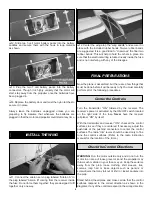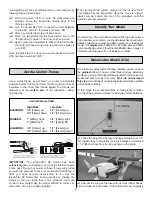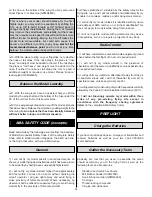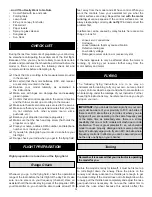
…And If You Really Want to Go Nuts
•
Cooler filled with ice and soda
•
Folding table
•
Lawn chairs
•
EZ-up or canopy for shelter
•
First-aid kit
•
Paper towels
•
Spray-on glass cleaner
•
Sunglasses
•
Sun block
During the last few moments of preparation your mind may
be elsewhere anticipating the excitement of the first flight.
Because of this, you may be more likely to overlook certain
checks and procedures that should be performed before the
model is flown. Look over the following check list and
complete all items before attempting to fly.
❏
Check the C.G. according to the measurements provided
in the manual.
❏
Be certain that the motor batteries, ESC, and receiver
are securely mounted in the fuse.
❏
Balance your model
laterally
as explained in
the instructions.
❏
Make sure all hinges are damage-free and securely
glued in place.
❏
Confirm that all controls operate in the correct direction
and the throws are set up according to the manual.
❏
Make sure that all servo arms are secured to the servos.
❏
Make sure that any servo extension wires that you have
do not interfere with other systems (servo arms,
pushrods, etc.)
❏
Balance your propeller (and spare propellers).
❏
Make sure that the hex head cap screw that holds the
propeller on is tight.
❏
Place your name, address, AMA number, and telephone
number on or inside your model.
❏
If you wish to photograph your model, do so before your
first flight.
❏
Range check your radio when you get to the flying field.
Flight preparation is to be done at the flying field.
Whenever you go to the flying field, check the operational
range of the radio before the first flight of the day. First, make
sure no one else is on your frequency (channel). Have an
assistant hold the model, staying clear of the propeller. With
your transmitter on, you should be able to walk at least 100
feet away from the model and still have control. While you
work the controls, have your assistant tell you what the
control surfaces are doing. Repeat this test with the motor
running at various speeds. If the control surfaces are not
always responding correctly, do not fly! Find and correct the
problem first.
Interference can be caused by many factors; here are some
things to look for:
•
Loose servo connections
•
Corrosion
•
Loose hardware that may cause vibration
•
Defective radio gear
•
Low battery voltage
•
Damaged receiver antenna or receiver crystal
If the radio appears to only be affected when the motor is
running, try moving your receiver farther away from the
motor battery and motor.
The following flying instructions are in no way an
endorsement for learning to fly on your own, but are printed
so you can know what to expect and what to concentrate on
while learning under the tutelage of your instructor. Further,
these flight instructions may be referenced once you begin
flying on your own.
Before the model is ready for takeoff, it must be first set up
to roll straight down the runway. Place the plane on the
runway and slowly advance the throttle just enough to get
the model rolling. If the model does not roll straight down the
runway, pull the throttle back completely and adjust the nose
gear pushrod as necessary. Do not use the rudder trim to
correct the nose wheel because this will also affect the
Remember, it is assumed that your instructor is operating
the model for you.
Taxiing
IMPORTANT: If you do insist on learning to fly on your own,
you must be aware of your proximity to R/C club sites. If
there is an R/C site within six (6) miles of where you are
flying and if you are operating on the same frequency and
at the same time as somebody else, there is a strong
possibility that one or both models will crash due to radio
interference. There is great potential for an out-of-control
model to cause property damage and/or severe personal
injury. We strongly urge you to fly at an R/C club site where
frequency control is in effect so you can be assured you will
be the only one flying on your channel.
FLYING
Range Check
FLIGHT PREPARATION
CHECK LIST
13


































